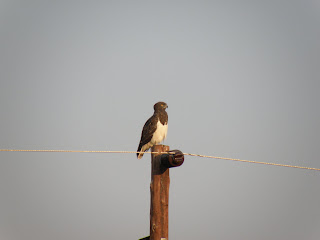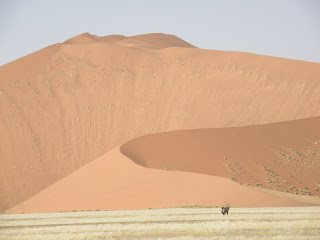Hello Namibia!
We spent a week (July 3-8) in the Namibia's capitol Windhoek where Kristi presented her paper at the 2011 World Conference on Sustainable Value Chain Agriculture for Food Security and Economic Development. The highlights were the bonfire dance performance at a reservoir and game meat BBQs (the favorite meat I think was Ostrich but the Kudu, Zebra, and Springbok were good too…crocodile, not so much). Then we were off again to take in the sites. We started at the NWR (Namibia Wildlife Resorts much like the Park Service) office in Windhoek to reserve 3 weeks of camp spots in the Parks. We headed south to Namib-Naukluft Park and then Sesriem Canyon-Sossusvlei with a stopover in Luderitz coastal town before Fish Canyon, then Kgalagadi, then northwest coast (Swakapmund/Skeleton Canyon) and then interior Waterberg Park (near Etosha) before heading to Botswana.
Interesting things we’re noticing in Namibia compared to S. Africa – Warmer temps (and colder at night) …definitely this is a desert. It looks a LOT like New Mexico and Utah (eerie). Grasslands, shrubs, rock formations, desert feel. Namibia is mostly remote – there is one north/south highway and one east/west highway. Everything else is dirt and gravel road. And Namibia is BIG (bigger than Texas). Everyone does the ‘thumbs up’ instead of waving. So, only passing car you see for hours: thumbs up. Saying hello across the street as you’re walking: thumbs up. Also there is a huge German presence here – a mix of German, Afrikaans, and English spoken mostly although we do hear Damara/Nama (language with clicks) a lot more than I thought we would (more with people socializing). People here are multi-lingual…it’s pretty amazing to see. Example, yesterday a park ranger giving us a park pass was speaking to us in English, the next person in German or Afrikaans, then to her co-worker in Nama I think. Wow. Also, a strange thing: one-way trails. You can only hike one direction on the loop trails - interesting.


NAUKLUFT TRAIL
Leaving Windhoek, we totally underestimated the time to get to Naukluft the first day – looong dirt roads - and ended up getting to our campsite right at sunset when the gates closed. Phew – too close for comfort! Next morning we set out on the Waterkloof (water ravine) trail. Beautiful beautiful canyon and amazing birds – colorful rosyfaced lovebirds too! - and other wildlife: klipspringers, hyrax, crazy frogs, mountain zebras and I swear I saw baboons climb a vertical cliff (at least a 5.9) when we startled a huge troop of them. Campsites there are in the backcountry - but amazingly still had hot showers and of course the reliable braai (BBQ) set up! We have our own camp stove so we’re mostly cooking camp meals but every once in a while braai’ing whatever flavor game meat they are selling at the park store.






BIRDS
Martial Eagles (pair)
Grey Louries
Pale Chanting Goshawks
Pale-winged Starlings
Red-eyed Bulbuls
Black-chested Prinias
Arnot’s Chat
Mountain Chat
Yellow-bellied Eramomela
Cape Pinduline Tit
Pririt Batis
Cape Wagtail
Whitetailed Shrike
Brubru
Scarletchested Sunbird
Great Sparrow
Lesser masked Weavers
Sociable Weavers
Black Eagle
Laughing Dove
Rosyfaced Lovebirds
Ashy Tit
Harp’s Tit
Redbilled Quelea
Melba Finch
Ruppell’s Korhaan
Black Crow
Short-toad Rock Thrush
Fiscal Shrike
Bokmakierie
Pied Starling
Black shouldered Kite
Ostriches
OTHER WILDLIFE
Mountain Zebras
Kudus
Common Platanna (frog)
Striped Grass Frog
Baboons (30)
Rock Hyrax
Klipspringers
Springbok
SOSSUSVLEI (“sossus – vley’)
From Naukluft, it was only an hour drive to Solitaire – this ‘filling station’ in the MIDDLE of the desert…NOTHing else around it…but somehow it had internet. Thank goodness because unfortunately a) we need it to do our online jobs and b) Namibia seems in short supply of reliable/affordable internet. (We definitely take it for granted back home). Another hour to Sossusvlei Dunes - HUGE red sand dunes in the middle of desert grasslands/conglomerate strangeness. It’s amazing! We arrived mid day at Sossusvlei and got an awesome camp site and headed straight to the park to see wildlife and climb a dune at sunset. Beautiful! We saw our first Oryx! (Seeing our brother Orxy reminded us of White Sands Missile Range and experiences with friends there. We miss you guys!)
Next day we caught sunrise on the dunes - we entered the park at the crack of dawn, then to the 2wd car park at the end, then hired a refuge concession/safari truck to take us 4x4ing on the dunes out to the jumping off point for several “vlei” (ephemeral pan in the middle of huge dunes) hikes. Cool wildlife: gi-normous ostrich ‘monstrich’, hundreds of springbok, 2 bat-eared foxes, an adder snake, tons of birds (see list below). We were done/it was warming up by 10 a.m. The rest of the day we caught up on reading/relaxing after a quick visit to a conglomerate Sisriem canyon. Charles made an awesome braai dinner – game meat, instant mashed potatoes and wine/beer.










On to Luderitz (German coastal town, definitely overhyped in the lonely planet) Tuesday night to do laundry, check internet and then back on the road to Fish Canyon Wednesday afternoon. HUGE THANK YOUs to Ed/Sara for giving us the penny coke can stove – we use it almost every day! Also Paul and Kim – we use the day packs every day! And dad, thanks for fixing my binocs – I’m using those all the time! Thanks to everyone – you’re definitely on this trip with us. We talk about our family and friends all the time and how much we miss everyone. We’re looking forward to being back for sure, but for the next couple months, we’ll TRY to enjoy it here and share with you as much as we can!
BIRDS
Doublebanded Courser
Whitenecked Raven
Pied Crow
Greater Kestrels
Ruppells Korhaans
Ludwig’s Bustards
Pale Chanting Goshawks
Blackwinged Stilts
Avocets
Threebanded Plover
Spotted Dikkops
Namaquua Doves
Redeyed Bulbuls
Blackchested Prinia
Privet Battis
Palewinged Starling
Sociable Weavers
Yellow Canaries
Melba Finch
Ostriches
Rock Kestrel
Lanner Falcon
Black Crow
Northern Black Korhaans
OTHER WILDLIFE
Springbok
Bat-eared Foxes
Oryx
Puff Adder (snake)
Blackbacked Jackal
Plains Zebra
Suricate/Meerkat
Steenbok
Horned Adder (snake)
Wild Horses
FISH CANYON TO KGALAGADI PARK
From Luderitz we headed to the southern border (Namibia/South Africa) along the beautiful Oranje River. Incredible sunset colors on the rocks. We stayed over at the very popular Ai-Ais hot spring oasis. We see one or two cars after HOURS of driving and then WHAM – hundreds at this hot spring camping resort. The transition from solitude and desert desolation to camp city with a restaurant and pool is totally nutty. Next day we headed to nearby Fish Canyon (supposedly ‘big-as-the-Grand-Canyon’) but were quickly disappointed. The overlook was fine (nice canyon but nowhere near the Grand Canyon) but they don’t let anyone hike, just overlook the canyon! Oh noo! Some tourist died in 2001 and now for some reason they just closed it off –so we changed our camping reservation and took off to Kleetsmanhoop to get in some internet time and start heading to Kgalagadi. (Check out the canyon pic – notice, no riparian veg. We are strangers in a strange land).
CHEETAHs! ~20k outside Kleetsmanhoop, we saw three cheetahs hanging right on the side of the road. What? Crazy! Loads of raptors too – Martial eagles, goshawks, lanner falcons, mating secretary birds –whoa. You can definitely tell where the desert transitions to the Kalahari –it’s pretty remarkable. We’d watched “The Gods Must Be Crazy” right before leaving on the trip so this desert was instantly recognizable. We camped at a private rest camp ‘Farmstall’ right by the border of the Transfrontier Park (South Africa and Botswana) - Holy crap its cold here!! Remarkably cold!! We wanted to rustic camp by the border (full moon too – bonus!) so we’d be close to spend the whole day slowly traveling to our reserved camp. One of the strangest things for us is having to make camping reservation – we’re used to just heading a direction and winging it, so this is a new concept for us. And there are a LOT of long dusty roads. (I’m going to have to do about 10 netty-pots when I get the chance.) But it does make you slow down and arriving yesterday here at dark, we saw an AARDVARK! Also, porcupine, strange foxes (with black tale) and the tiniest antelope you’ve ever seen – I think smaller than the Brockett deer in Belize. Wooo-eee-uuuu-oooooo. Strange. But cool.


BIRDS
Hammerkop
Grey Heron
Southern Masked Weaver
African Sedge Warbler
South African Shelduck
Redeyed Bulbuls
Laughing Doves
Yellow Canaries
Pale Chanting Falcons
Lanner Falcon
Secretary Birds (copulating)
Martial Eagles (pair)
OTHER WILDLIFE
Baboons (2 troops)
Cheetahs (3)
Rock Hyrax
Aardvark
Porcupine
Unidentified Foxes (with black-tipped tail)
Unidentified tiny ungulate (brocket deer size and shape, maybe smaller)
KGALAGADI PARK and KALAHARI DESERT
We decided to visit Kgalagadi (South Africa part bordering with Namibia) on this part of our trip because it’s the closest in proximity to where we plan to travel. In other words, it was only 1 whole day’s driving in desolate Kalahari desert conditions barely seeing other cars versus driving a much longer distance in Botswana later on. We’d heard Kgalagadi was not to miss from Jackie, Ronnie, Anel, and Innie on our first days in South Africa a month ago before entering Kruger Park. So here we are!
We entered Kgalagadi Transfrontier Park from Namibia rather painlessly through a one-room customs/immigration office and then onto Mata Mata rest camp a few steps away in South Africa. We lost an hour though in the time change but made up for it in a birds and wildlife list – see below. It took 6 hours to cover 120 kilometers! We entered the rest camp – a gated camp to keep predators out - right at 6 p.m. closing time (we’re getting good at this timing!) The rest camp is on the border of Botswana and South Africa. We’ll drive north to explore more of the park and the Kalahari Desert and exit through the Mata Mata gate again to Namibia to continue our Namibia journey there.
We got an early start the second day – self safari’ing right when the gates opened at sunrise. It paid off – we watched 2 lions in the distance – one nice sized male - very cool! The morning was nice-loads of springbok, wildebeest, orxy and ostrich, birds and raptors galore… and surprisingly a lot of steenbok and jackals. Everything we saw was so close to the road – this is one of the best close range wildlife viewing places there is – although it’s big and the bumpy dirt roads take all day between camps. The afternoon was a long slog back to Mata Mata camp and the Namibia border to cross tomorrow on the way to Windhoek. We’re on the fence a lot of times, trying to balance work with play. Southern Namibia is SO remote and internet so sparse and expensive - I think we’re really looking forward to northern Namibia… but the south was incredible, desolate, sparse, barren...and so beautiful. Good memories!









BIRDS
Titbabbler
Cinnamonbreasted Shrike
Sociable Weavers
Melba Finch
Southern Yellowbilled Hornbill
Lilacbreasted Roller
Blackshouldered Kite
Greater Kestrel
Kori Bustard
Pale Chanting Goshawk
Martial Eagles
Crowned Plover
Redbilled Hornbill
Shafttailed Wydahs
Yellow Canaries
Cape Sparrow
Ground Scraperthrush
Black Crows
Forktailed Drongo
Namaqua Doves
Scalyfeathered Finch
Whitebrowed Sparrow-weaver
Ostriches (lots)
Booted Eagle
Redcrested Korhaan
Rednecked Falcon
Jackal Buzzard
Kalahari Robin
Turtle Dove
Bearded Woodpecker
Familiar Chat
Gabar Goshawk
Northern Black Korhraan
Chat Flycatcher
Beurchell’s Sandgrouse
Bateleur
Barn Owl
OTHER WILDLIFE
Slender Mongoose
Springbok (lots)
Common Duiker
Blue Wildebeest (lots) (note: Black Wildebeest in Kruger)
Oryx (lots)
Black-backed Jackal
Cape Ground Squirrel (lots)
Kudu
Lions
Steenbok
Oribi
Bat-eared Fox
Suricate/Meerkat
























































